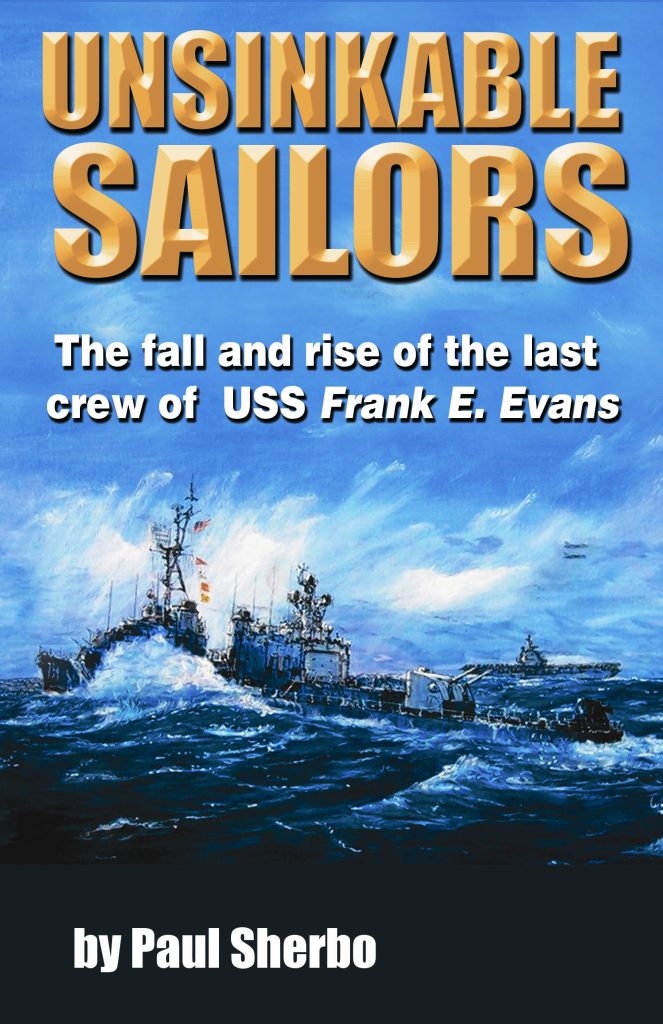Unsinkable Sailors by Paul Sherbo

Dr. Sam Bateman
Time passes all too quickly. It is now over forty years since the tragic events in the South China Sea during the early morning of 3 June 1969 when the Australian aircraft carrier HMAS Melbourne collided with the destroyer USS Frank E. Evans cutting the smaller vessel in two. Evans’ detached bow sank almost immediately while the stern section remained afloat and was later towed into port and decommissioned. 74 American sailors lost their lives in the accident.
Unsinkable Sailors tells the story of the accident in the context of its impact on the surviving crew members of the Evans. Written from official records, interviews with survivors and transcripts from the subsequent board of investigation, Unsinkable Sailors is very much a human story of tragedy, loss, survival and perseverance as the survivors got on with their lives. Although this book is relatively short, there is much to reflect upon in terms of the potential dangers of sea service with warships working in close company at sea, and of the lessons to be learned to ensure that similar accidents do not occur in the future, as well as with managing the personal stress imposed on military personnel after a traumatic experience such as that suffered by the last crew of the Frank E. Evans.
It was a tragic coincidence of the Melbourne – Evans collision that just over four years earlier, the Melbourne had been involved a similar accident. On the night of 10 February 1964 off Jervis Bay on the southeast coast of Australia, Melbourne had run down the destroyer HMAS Voyager cutting her in half. As with the Evans, the bow section of the Voyager sank almost immediately; the stern section remained afloat for some hours before finally sinking. 82 crew members of the Voyager were killed.
There are some remarkable similarities between the two collisions. Both involved a destroyer taking up a rescue destroyer (RESDES) station or plane guard station astern of an aircraft carrier. Both involved some misinterpretation of manoeuvring signals and poor ship-handling (or lack of a seaman’s eye) on the part of the destroyer. In both cases, the destroyer started the manoeuvre from ahead of the carrier, but whereas the Evans misinterpreted the course of the Melbourne by eighty degrees, the Voyager thought that the larger ship was turning away during the manoeuvre to an almost reciprocal course. The captain of the Evans was not on the bridge at the time of this potentially dangerous situation presented by a destroyer manoeuvring in close proximity to an oncoming larger ship proceeding at speed. Both situations were also exacerbated by the difficulties experienced by the destroyers in assessing the heading of the carrier due to the location of her steaming lights and other lighting onboard.
Unsinkable Sailors is an informative book that captures well the naval environment of Southeast Asia in the 1960s when the Southeast Asian Treaty Organization (SEATO) was still active, the Vietnam War was at its peak and the British Commonwealth navies were still adjusting after the Indonesia-Malaysia Confrontation of the 1960s; the undeclared war between Indonesia and United Kingdom-backed Malaysia over the future of Borneo. The two navies involved in the Melbourne – Evans collision were under considerable pressure at the time of the accident; the USN with the Vietnam War and the RAN with fighting two wars in Southeast Asia – the Vietnam War and Confrontation.
This stress is evident in the calibre of the officers onboard the Evans in particular. As may have been the case with the FRAM conversion World War II vintage destroyers generally during the Vietnam War, the Evans’ officers were rather a second division of skill and experience. The commanding officer, Commander Albert S. McLemore USN, seems to have had remarkably little bridge experience for an officer in command of a destroyer. He had trained as a merchant marine engineer and his main previous sea postings had been as an engineering officer. Evans’ OOD at the time of the collision, Lieutenant JG R.C. Ramsay USN, was only commissioned through the Reserve Officer Training Corps (ROTC) program in 1967 and had served at sea for just 20 months.
Despite the obvious faults of the two destroyers, the subsequent boards of investigation after the accidents attributed some blame to the Melbourne mainly for not appreciating sooner that a dangerous situation was developing and issuing appropriate warnings to the destroyer. Although neither was convicted by court martial, this was the end of the careers of the two Australian captains involved – Captain R.J. Robertson RAN in the case of the Voyager collision, and Captain J. P. Stevenson RAN in the Evans collision.
Unsinkable Sailors is a fine book, well researched, well written, and generally captivating. Much of its appeal lies in the way it captures the human side of the Melbourne – Evans collision. This is achieved though transcripts from the board of investigation and interviews with Evans’ survivors some conducted at USS Frank E. Evans (DDG-754) Association reunions. There is much pathos and mateship in the story. Tragically three brothers, from the Sage family of Niobara, Nebraska, were all lost in the collision.
The survivors have dealt with this traumatic event in different ways, but all have got on with their lives despite little help initially from the Navy in dealing with the trauma of the collision. As the book’s title suggests, they were ‘unsinkable sailors’. Commander McLemore died in 2001, and Lieutenant Ramsay left the Navy two years after the accident. He has had no association with the Evans’ Association.
In 1999, on the 30th anniversary of the collision, American and Australian survivors gathered at the War Memorial in Sydney’s Hyde Park. The two navies have served together in many wars and one small benefit of the collision is that it has helped to bring these two navies even closer together.
Review Author
Dr. Sam Bateman is a professorial research fellow in the Australian National Centre for Ocean Resources and Security (ANCORS) at the University of Wollongong in Australia. He is former Commodore (one star) in the RAN who held four ships commands during his 39 years of naval service: two patrol boats, an ASW frigate and a Charles F. Adams Class DDG.
Military Writers Society of America Book Review
Unsinkable Sailors: The fall and rise of the last crew of the U.S.S. Frank E. Evans by Paul Sherbo.
Collisions and accidents at sea are always tragic events. Not all lead to the results as in the case of the USS Frank E. Evans in 1969. Having experienced such an event, but with no deaths involved I easily identified with this story.
First impressions would have folks shaking their heads “how can ships collide on a large ocean.” Naval ships operate at times in rather close formations for large vessels. This is not turning a corner in your corvette, a lot of room is required and above that, good solid communication and attention by all responsible for keeping their collective eyes on what is going on.
The story would be of great interest to sailors and history buffs. It would help greatly those who have not or do not travel on the seas. It awakens you to the dangers that exist at every minute on board a ship. An error such as what happened in this event takes numerous lives, the ocean is unforgiving.
The nature of the story may turn off the casual reader who is used to Hollywood’s action packed thrillers, but do not put the book down. This book will result in your learning something new and you will come away from it with a new pride in those that serve in the U.S. Navy.
This is a story of tragedy and survival, as the efforts of many resulted in the saving of numerous lives that would have been lost if not for the combined efforts of all.
Review by Military Writers Society of America, July 23, 2011
